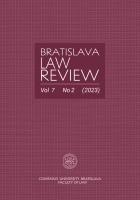Overview of the Church’s Property Law in the Czech Lands during the Middle Ages
Overview of the Church’s Property Law in the Czech Lands during the Middle Ages
Author(s): Pavel KraflSubject(s): Law, Constitution, Jurisprudence, History of Law
Published by: Univerzita Komenského v Bratislave
Keywords: Medieval Canon Law; Church’s Property Law; Immunity of Ecclesiastical Estates; Bohemia and Moravia
Summary/Abstract: Aim of the study is to provide an overview of the issue of Church property law in Bohemia and Moravia during the Middle Ages. Specifically, we consider the territory of the Prague and Olomouc dioceses. The main founder of churches and ecclesiastical institutions in the early Middle Ages was the duke, while from the 12th century magnates also became involved in founding these institutions. In the early period of founders, the property donated to the Church was treated in the spirit of respecting the rights of the proprietary churches. The law of patronage, which was progressively implemented during the 13th century and first half of the 14th century, brought change. In order to exclude the assets of ecclesiastical institutions, including the serfs who lived there, from the general legal system, immunities were important. Bishoprics and individual monasteries received immunity documents from the mid-12th century, and to a greater extent from the early 13th century.
Journal: Bratislava Law Review
- Issue Year: 7/2023
- Issue No: 2
- Page Range: 31-56
- Page Count: 26
- Language: English

